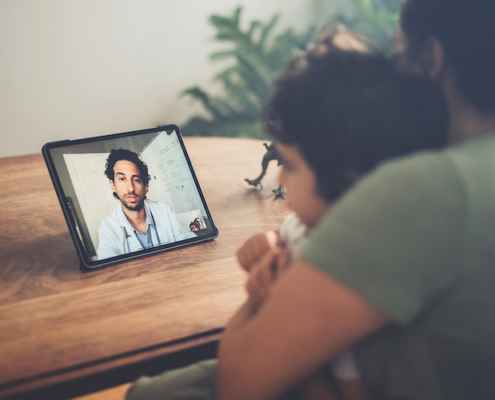Telehealth and the changing medical landscape post pandemic
Telehealth and the changing medical landscape post pandemic
By Ken Winell, Chief Technology Officer, Greater Than One
At the start of 2020, telemedicine grew at a reasonable rate as convenience took hold; this was short-lived. As the pandemic progressed, telemedicine companies experienced explosive growth. With persons still wanting to consult with physicians, doctors embraced the platforms whole-heartedly, especially as the US government suspended regulations that would limit by geography. The key question from investors and industry stakeholders is whether the telemedicine increase will be sustained post pandemic, or how it will transform. This article will explore and offer considerations to how innovation and changes in telemedicine can fit comfortably, and successfully, into the U.S. healthcare ecosystem.
Part one:
Telemedicine from 2010 – 2020:
Telemedicine is not a new concept as a result of the pandemic. In fact, remote treatment for ailments was described in the 1900s as the telephone made its way into households. Physicians located significant distances from rural patients being able to diagnose and offer treatment advice via telephone was considered a tremendous advancement at the time.
With the internet, removing distance as an obstacle was exponentially amplified. In the early part of the 21st century, telemedicine was limited to adoption, however, it quickly found its way to supply care teams and specialists an ability to collaborate and help local providers treat difficult cases.
Many companies found that not only could persons contact physicians remotely, but moreover could schedule home appointments using medical vans. While these services lack an immediate scalable platform, they meet local needs to deliver patient care.
Part two:
Pandemic and the Rocket Ship:
 The perfect storm of a global pandemic, an overloaded healthcare system, and an accelerated technology landscape was key to telemedicine adoption. Many platforms such as Teledoc, Livongo, and MDLive watched their growth rates leap from 20 to 30 percent to 1,000 percent in the span of a few months as more physicians adopted telemedicine as a standard, and regulators and legislators approved temporary access for interstate practices to assist persons who were stranded due to COVID-19 restrictions.
The perfect storm of a global pandemic, an overloaded healthcare system, and an accelerated technology landscape was key to telemedicine adoption. Many platforms such as Teledoc, Livongo, and MDLive watched their growth rates leap from 20 to 30 percent to 1,000 percent in the span of a few months as more physicians adopted telemedicine as a standard, and regulators and legislators approved temporary access for interstate practices to assist persons who were stranded due to COVID-19 restrictions.
During this time, telemedicine became a mainstay for both mental health platforms and new platforms such as Lemonaid Health, which offer a cultural sensation that goes beyond the typical patient experience as media promotions encouraged folks to remain indoors. Not only did telehealth benefit communities, but insurance companies embraced the new normal as it dually lowers costs and streamlines merging electronic health records (EHR). This “one stop shopping” experience revealed an innovative answer to offer convenience and reduce costs and will continue to expand post pandemic.
Remote monitoring devices like Fitbit, Garmin, and Halo additionally saw massive spikes during the pandemic. This accelerated technology provided diabetics and cancer patients an effortless ability to report key medical parameters including glucose, pulse ox, and even ECG information to their doctors who could observe and enforce medical intervention if necessary.
Part three:
Post Pandemic:
 The impact of a digitally connected health ecosystem is only just starting to be experienced. Clinical trial enrollment, long a cryptic and arcane process, can now do intelligent searches against many EMR systems to identify potential candidates for a trial. From the health care provider perspective, adherence to medical prescriptions and treatments by reviewing daily data from their patients are providing insights never observed before. Not only do patients benefit by having a proactive medical intervention, but health care providers benefit with a reduced time treating more severe ailments.
The impact of a digitally connected health ecosystem is only just starting to be experienced. Clinical trial enrollment, long a cryptic and arcane process, can now do intelligent searches against many EMR systems to identify potential candidates for a trial. From the health care provider perspective, adherence to medical prescriptions and treatments by reviewing daily data from their patients are providing insights never observed before. Not only do patients benefit by having a proactive medical intervention, but health care providers benefit with a reduced time treating more severe ailments.
Perhaps the biggest impact of telehealth in our health ecosystem is on the severity of emergency room visits. On average, 80 percent of ER visits are not true medical emergencies, treating for colds, flu, and other minor conditions which can be significantly reduced via virtual appointments. Physicians can provide prescriptions, perform video examinations, and dispense care more readily, providing an efficient experience that both saves the patient and caregivers time, while freeing up emergency room services for more severe cases. Although hospitals may lose revenue, the streamlined process lowers the costs of medical treatments and offers a valuable and convenient experience.
Conclusions:
If the pandemic taught us anything, it showed that innovation and adoption were significant catalysts for telemedicine. As we emerge from the lockdowns and COVID-19 subsides, digital transformation in the healthcare industry has the opportunity to remain a mainstay. Even now, just looking to get an appointment with a local medical group typically has an online “Patient Portal” which gives the consumer the ability to book a telehealth appointment, contact an in-network physician, look up medical history, and provide disease and treatment information, all from a mobile phone. With blockchain and medical record management being in the hands of consumers, opportunities like never before are arising such as providing medical information to multiple healthcare providers, sharing breakdowns of long-term treatments to therapists, and supplying remote monitoring data to physicians. Telemedicine is here to stay, so take advantage of it.
REFERENCES:
https://www.ncbi.nlm.nih.gov/books/NBK207141/




